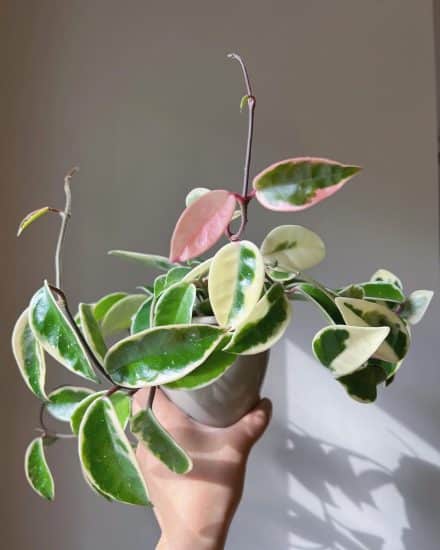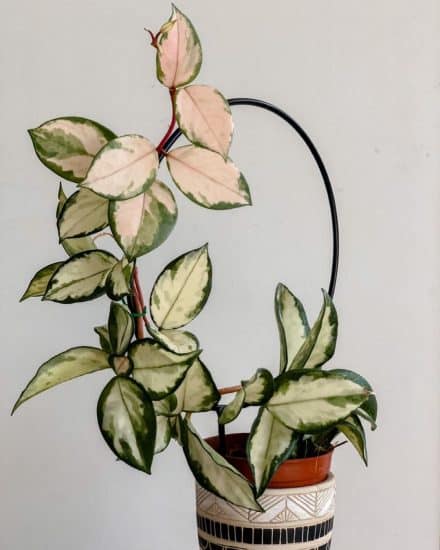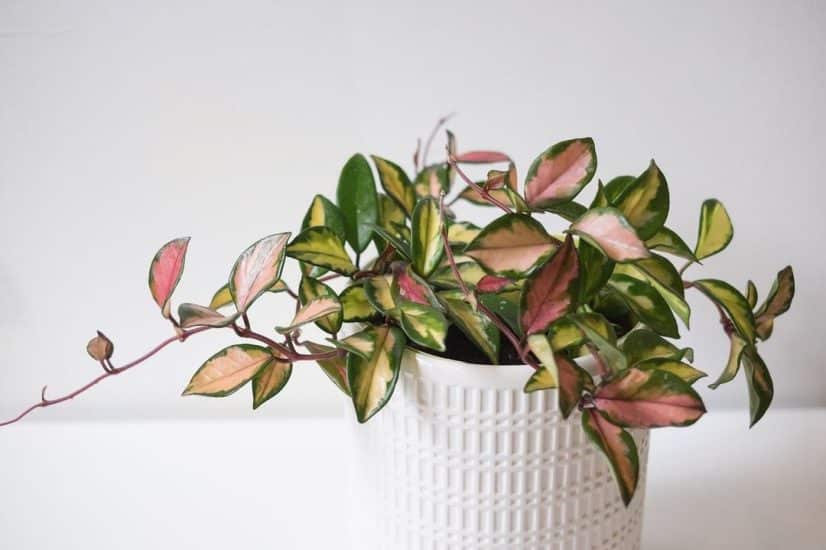The Hoya Krimson Princess is like the Instagram-famous sibling of the houseplant family, with stunning variegated leaves that will enthrall your plant-loving followers.
We’re going to get up close and personal with this regal houseplant as we guide you through everything you need to know about Hoya Krimson Princess care, from creating ideal conditions to propagating this royal beauty.
Table of Contents
Hoya Krimson Princess Plant Care Guide
History, Habitat, and Characteristics

Hoya Krimson Princess (Hoya carnosa ‘Krimson Princess’), a popular indoor plant native to Southeast Asia and Australia, is an absolute stunner.
With its impressive variegation and low-maintenance care requirements, it’s a royal favorite among gardeners of all experience levels.
Hoya Krimson Princess plants feature pink vines complemented by thick, waxy leaves with green centers and creamy edges. As they mature, their new leaves emerge with a radiant pink hue, eventually fading to the familiar light pink, creamy, and off-white shades.
Fun fact: The Hoya Krimson Princess sometimes goes incognito under alternative names like Hoya Strawberries and Cream, thanks to its delightful pink and white leaf variegation.
Mature Krimson Princess hoyas bloom indoors with fragrant pink flowers in the shape of stars.

Related Varieties

In the world of variegated hoyas, things can get a bit tricky. You’ll see a few plants with very similar names and often confusingly similar appearances, like Hoya Krimson Queen. Occasionally, vendors mistakenly sell Hoya australis ‘Lisa’ cuttings as Hoya Krimson Princess, causing a mix-up in the horticulture realm.
To distinguish these hoya plants, let’s take a look at the differences in leaf shape and texture. Hoya carnosa varieties have longer, less round leaves with a thicker, waxy surface, while Hoya australis features rounder, thinner, and more delicate leaves.
So, when you’re exploring this kingdom of variegated plants, remember this little nugget of wisdom: The Queen (Krimson Queen) wears her white like a crown (outer edges), while the Princess (Krimson Princess) wears her white like a gown (inside of the leaf).
Happy gardening, and long live the royals!
Light

Unlike many indoor plants, Hoya carnosa ‘Krimson Princess’ can actually tolerate some direct sunlight.
In most homes, east-facing windows work wonders, offering morning sun and less intense afternoon sun. However, west-facing windows can also do the trick, as long as their direct light is filtered in the afternoon, providing a healthy dose of afternoon and evening brightness.

Now, let’s talk about the signs of too much light. If the leaves start to discolor, look bleached, or develop small holes, it’s a hint that the sun is overdoing it. A couple of solutions to try: sheer curtains to soften those rays, or a quick relocation to gentler, dappled sunlight.
On the other hand, without enough light, you may start to see slow, leggy growth or loss of vibrant colors. No need to panic! Just scout out a brighter spot, or consider full-spectrum LED grow lights to give your plant the bright light boost it needs. In the end, striking the right light balance holds the secret to a flourishing Hoya carnosa ‘Krimson Princess.’
Water

Since this plant stores water in its thick, waxy leaves, it’s essential to water your Hoya Krimson Princess sparingly and look for cues from the plant itself.
The main sign of underwatering is visible in the leaves. If your Hoya Krimson Princess isn’t getting enough water, the lower leaves will begin to wrinkle and become more flexible than usual. When you notice these changes, it’s time to give your plant a thorough watering.
Signs of overwatering include yellowing leaves, especially throughout the plant, and potentially soft or mushy stems. If you observe these symptoms, scale back on your watering schedule and allow the soil to dry out before watering again.
Temperature and Humidity

When it comes to temperature, Hoya Krimson Princess prefers a range of 65-80°F (18-27°C) during the day, with a slight drop in temperature at night. Keep in mind that this tropical plant doesn’t respond well to extreme temperature changes.
Exposure to temperatures below 50°F (10°C) for extended periods can lead to wilted leaves, yellowing leaves, or a stunted growth rate. Similarly, too much sun and high temperatures can cause the leaves to become discolored or scorched.
Hoya Krimson Princess thrives in average room humidity, around 50%. While it’s not overly sensitive to humidity levels, excessively dry air might cause the waxy leaves to become crispy or develop brown edges. Conversely, too much humidity can increase its susceptibility to pests or fungal infections.
To increase humidity:
- Use a tray filled with water and pebbles under the plant pot to create a microclimate.
- Employ a room humidifier to maintain ideal humidity levels.
- Group your Hoya Krimson Princess with other plants, allowing them to share moisture through transpiration in their mutual space.
Avoid misting the plant’s leaves directly, as this can lead to water spots or fungal issues and doesn’t do much to create a humid environment.
Soil and Planting

Since a hoya plant (porcelain flower or wax plant) has a finer root system than some other houseplants, we really want to get the soil mixture right.
To create the perfect mix for your Hoya Krimson Princess, consider a blend of fine orchid bark, cactus succulent mix, and regular potting soil.
A cactus succulent mix blended with potting soil (the kind you can find at any garden center) helps retain the right amount of moisture while preventing excess water from accumulating. A 50/50 mix is just about right.
Adding fine orchid bark is perfect for this plant’s more delicate roots, while still providing aeration and drainage.
Tip: Prevent soil from escaping the pot during watering by placing a coffee filter at the bottom before adding the soil mix. This simple trick allows water to flow through while keeping the soil mix intact.
Fertilizer

Hoya Krimson Princesses can benefit from the occasional application of liquid houseplant fertilizer. They sometimes prefer a foliar spray, like Miracle-Gro Orchid Plant Food Mist. Alternatively, you can dilute a balanced liquid fertilizer.
To encourage its bright pink flowers to grow, consider using a higher phosphorus fertilizer. However, be mindful that too much fertilizer can cause yellowing leaves, weak growth, or brown leaf edges. If this happens, reduce the frequency or concentration of the fertilizer and flush the soil with water to leach out any remaining salts.
Repotting
Repotting your Hoya Krimson Princess may be necessary as the plant grows. Signs of overcrowded roots or soil breakdown indicate that it’s time to consider repotting.
When transferring your hoya, you can also consider using LECA (lightweight expanded clay aggregate) as an alternative growing medium that provides excellent aeration and drainage. Always use a pot with drainage holes to prevent waterlogging and promote healthy root growth.
Propagation

In this guide, we’ll teach you how to propagate your Hoya Krimson Princess using stem cuttings with either damp sphagnum moss or perlite. Follow these simple steps to expand your hoya collection!
Propagate Hoya Krimson Princess via stem cuttings:
- Gather your materials: Use sterilized gardening shears, a small container, and your choice of either sphagnum moss or perlite. If using sphagnum moss, make sure it’s damp but not soaking wet.
- Find a healthy stem: Look for a healthy stem with at least two to three leaves on it. It should be about 4-6 inches long and actively growing, with no signs of damage or disease.
- Snip the stem: With your sterilized shears, carefully snip the stem just below a node (where the leaf meets the stem). This spot is full of growth hormones that will help your stem cutting develop roots.
- Trim extra leaves: Remove any leaves from the bottom half of the stem cutting. This helps it focus its energy on growing roots, rather than maintaining leaves.
- Place the cutting in your medium: Put the prepared cutting in your chosen medium, either damp sphagnum moss or perlite. For either medium, gently submerge the bottom half of the cutting so that it is covered.
- Keep an eye on things: Monitor your cutting, ensuring the medium stays damp but not soggy. Maintain consistent warmth, light, and humidity to encourage rooting. It could take anywhere from a few weeks to a couple of months to grow roots.
- Pot your new plant: After the stem cutting has grown a healthy root system, transfer it to fresh soil in a well-draining potting mix. Make sure the new roots are covered by soil and watered generously. Keep your new Hoya Krimson Princess in a nice bright spot.
Common Issues

Hoya carnosa ‘Krimson Princess’ plants are generally low-maintenance and easy to care for. However, these tropical plants can still encounter a few common issues.
Excessive Runners

It’s not uncommon for Hoya Krimson Princess plants to produce runners and peduncles without leaves, which can be puzzling to plant owners. Avoid cutting these bare vines, as leaves will eventually grow on them.
An abundance of leafless vines is likely a sign that your plant needs more light. To resolve this issue, simply move it to a sunnier spot or supplement it with artificial light. This way, you’ll encourage the growth of new leaves and boost the overall health of your plant.
Leaves Turning Green

From time to time, your Hoya Krimson Princess leaves might revert to their original green color, rather than maintaining the spectacular variegated appearance they’re known for.
Although leaving the green parts intact won’t harm your healthy plant, removing non-variegated sections might encourage more variegated leaves to grow, allowing your Hoya Krimson Princess to truly shine with its stunning colors.
A return to its original green color can also be a sign of low light, as your plant produces more chlorophyll to capture the light it does have. Often, simply increasing the amount of filtered light can be enough to restore that beautiful variegation.
Pests and Diseases
Hoya Krimson Princess is a low-maintenance houseplant that can still face a few hurdles, such as excess water, pests, and fungus. But don’t worry! We’re here to help you address these issues fast.
Fungus
Fungus doesn’t discriminate — it can attack either the waxy leaves or colorful stems of your Hoya Krimson Princess, causing unsightly spots or patches.
Here’s how to address this issue:
- Separate the affected plant to avoid sharing the fungus with other green friends.
- Prune away any diseased leaves or stems, sterilizing your cutting tool afterward as a wise precaution to avoid spreading the fungus.
- Apply a fungicide as per the manufacturer’s instructions and maintain appropriate humidity levels to discourage fungal growth (your plant will breathe easier).
Root Rot
If you suspect your Hoya Krimson Princess is suffering from rot, don’t despair — it happens to the best of us!
Follow these easy steps to help nurse your disturbed roots back to health:
- Remove the plant from the pot: Gently take your Hoya Krimson Princess out of its container, taking care not to damage any healthy roots in the process.
- Inspect and trim: Examine the root system carefully, looking for any roots that are mushy, brownish, and emitting a foul smell — this is root rot. Using a clean pair of scissors or pruning shears, trim away the affected roots, ensuring you leave only healthy, undamaged roots behind.
- Clean thoroughly: Give your newly pruned root system a gentle rinse under running water. This will wash away any remaining rot and bacteria.
- Disinfect the pot: Disinfect the plant’s container with a mix of one part bleach to nine parts water. This will help prevent reinfection by eliminating any lingering pathogens. Alternatively, you can leave the pot out in the sun for a few days or switch to another container for this plant.
- Select new soil: Choose a well-draining potting mix, such as one created specifically for hoya plants, succulents, or epiphytes. This will encourage proper drainage, since excess water is often the cause of rot to begin with.
- Replant: Gently place your Hoya Krimson Princess back into its disinfected container, filling it with fresh, well-draining soil. Ensure the root system is fully buried and the plant is sitting at the same height as it was before. Fini!
Pests

Hoya Krimson Princess isn’t particularly pest-prone, but it can still encounter common indoor plant pests like whiteflies, mealybugs, or spider mites.
If you spot small white bugs, webbing, or odd leaf damage, it’s time to act:
- Isolate the affected plant to prevent pest-related drama among your other plants.
- Wipe the leaves, front and back, with a damp cloth to evict pests and their eggs (bye-bye, bugs).
- Treat severe infestations with neem oil or insecticidal soap, reapplying as needed. Patience is a virtue!
Remember, prevention is better than cure. Proper care for your Hoya Krimson Princess ensures it stays healthy and pest-free, guaranteeing it thrives for years to come (happy plant, happy you).
Conclusion

That’s a wrap for our Hoya Krimson Princess care guide! You now have all the knowledge to keep this stunning plant thriving in your home.
Hoya Krimson Princess care summary:
- Provide bright, indirect light, and adjust the plant’s location based on sun exposure and growth.
- Maintain comfortable temperatures (65-80°F / 18-27°C) and average room humidity (around 50%).
- Use a well-draining, moisture-retaining soil mix, and always use a pot with drainage holes.
- Fertilize occasionally with a diluted balanced fertilizer or foliar spray.
Remember, patience and attention to your plant’s needs are key to keeping it healthy and flourishing. With proper care, your Hoya Krimson Princess will provide stunning, variegated foliage and an elegant touch to your indoor garden for years to come.
We hope this guide was helpful for you! If you have further questions or need more assistance, feel free to reach out to us. And don’t forget to share your Hoya Krimson Princess successes with friends and fellow gardeners!
Take care, and happy gardening!
FAQ
Does Hoya Krimson Princess do well in a hanging basket?
Absolutely! The Hoya Krimson Princess is a perfect candidate for a hanging basket, as its beautiful trailing vines will cascade gracefully over the edge.
Expose your hanging plant to plenty of bright indirect light and be cautious not to overwater it: let the top 1-2 inches of soil dry out between watering sessions. With the right care, your Hoya Krimson Princess will thrive in its new aerial home.
Can you grow Hoya Krimson Princess outside?
While the Hoya Krimson Princess is typically grown as an indoor plant, you can certainly grow it outside in certain conditions. The ideal USDA Hardiness zones for growing the Hoya Krimson Princess outdoors are zones 10-11, where temperatures generally stay above 50°F (10°C) year-round. This tropical beauty will love being outside in these warmer climates.
If you’re in a suitable zone, find an outdoor location that mimics the indoor light conditions the plant prefers: bright, filtered sunlight with some protection from intense, direct rays. A sheltered spot like a covered patio will work wonders in protecting your Hoya Krimson Princess from harsh weather or sudden temperature drops.
For those living in cooler hardiness zones (below 10), it’s best to keep your Hoya Krimson Princess indoors, but you can still treat it to an outdoor summer vacation when temperatures are consistently warm! Just remember to gradually acclimate the plant to the outdoor environment to avoid shock. Keep an eye on the weather forecast to bring it back inside when temperatures begin to dip.
Is Hoya Krimson Princess toxic?
Hoya Krimson Princess is considered to be toxic to pets (such as cats and dogs) but is generally safe to handle by humans. To keep your four-legged friends safe, simply place the plant out of their reach. If you know you have adventurous animals that won’t be able to leave it alone, place it in a room they don’t have access to or consider a different plant.


